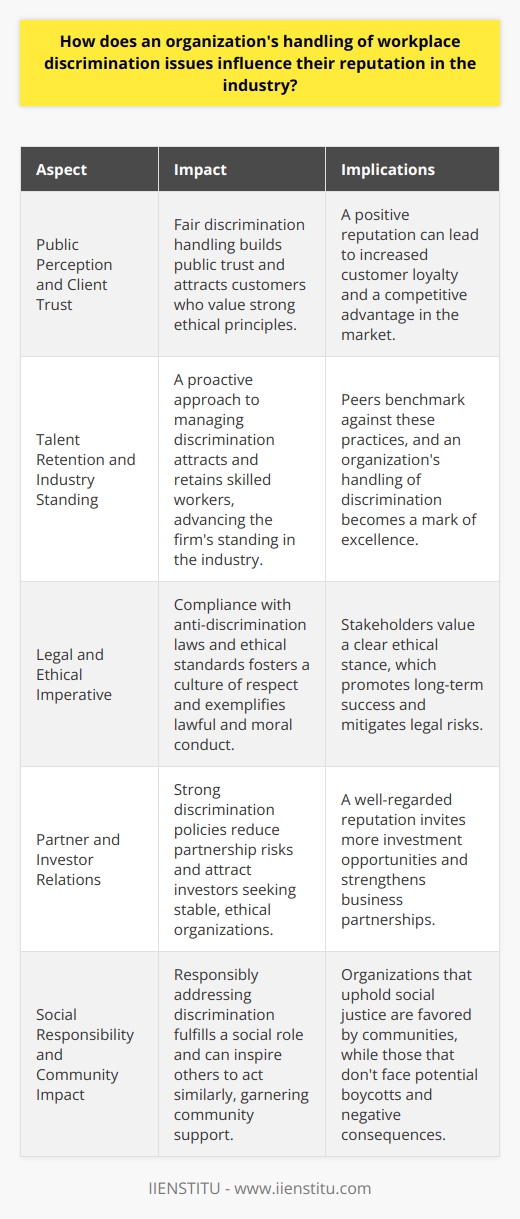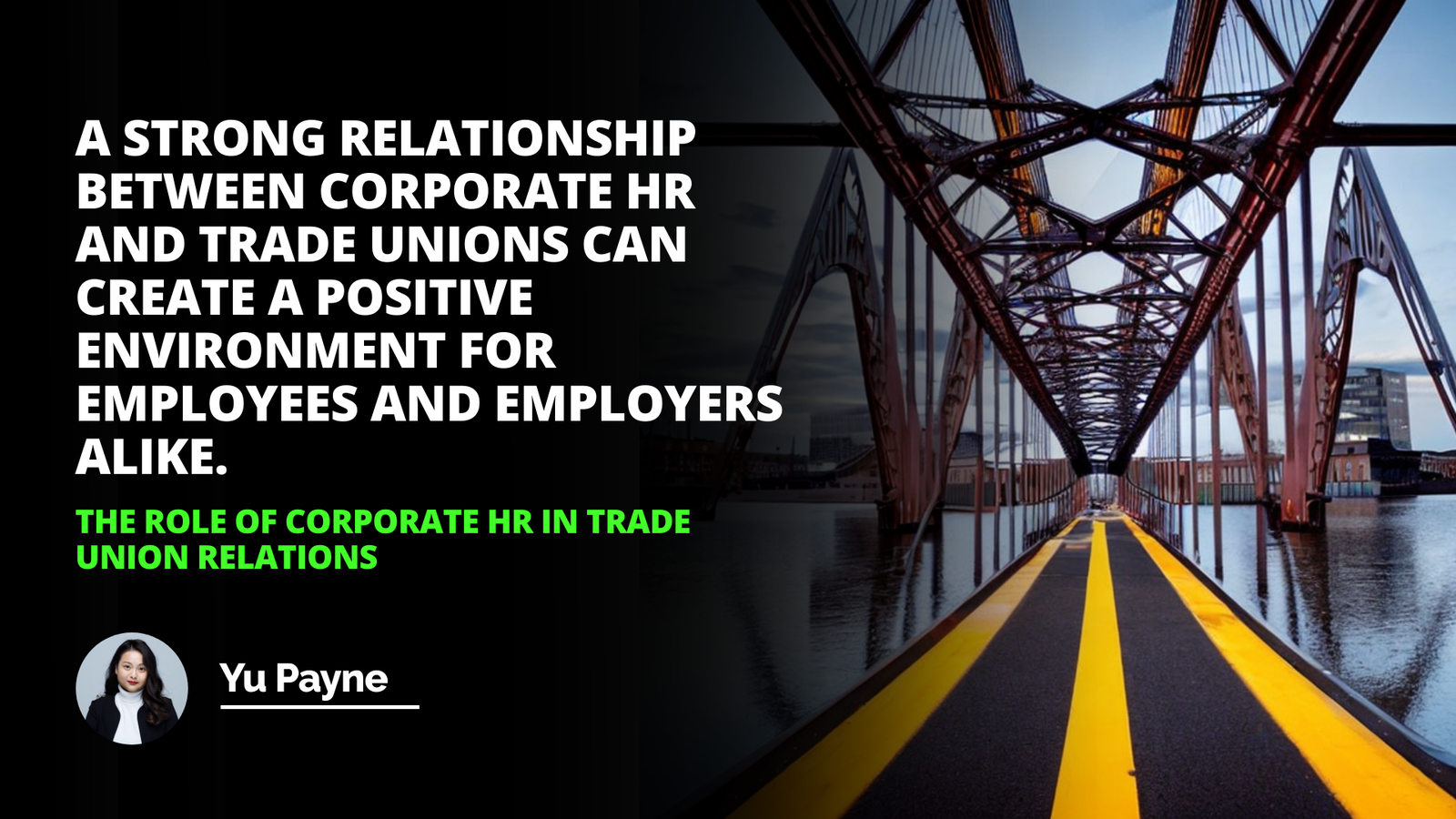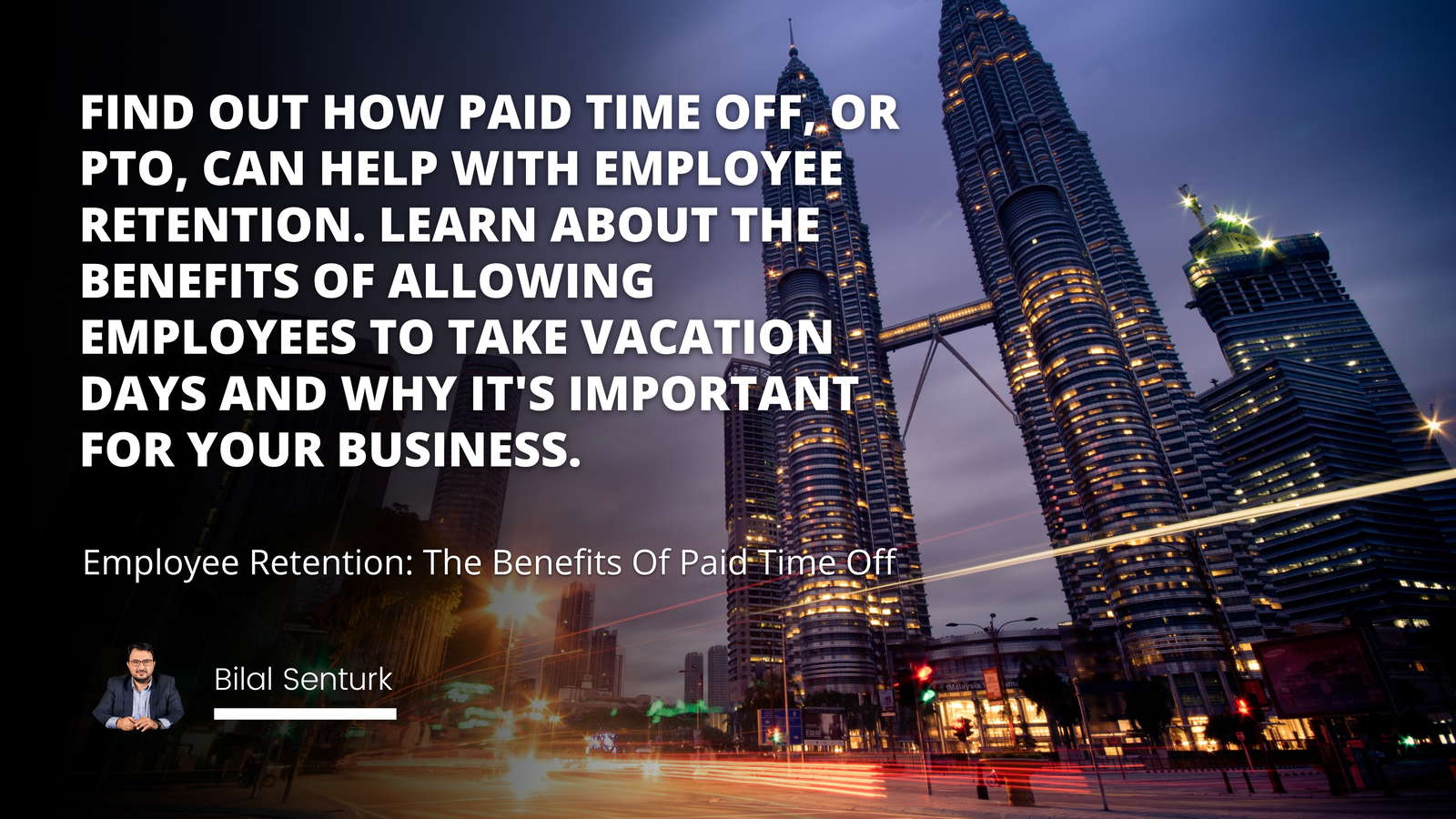
Workplace discrimination is a pervasive issue that not only affects individuals but also has far-reaching consequences for businesses and society as a whole. Despite the existence of laws and regulations aimed at preventing discrimination, it continues to persist in various forms, undermining the well-being and productivity of organizations.
In this blog post, we will explore the different types of workplace discrimination, the legal context surrounding it, its impact on employees, organizations, and society, and the steps that can be taken to prevent and handle discriminatory behavior.
The Various Types of Workplace Discrimination
Discrimination in the workplace can take many forms, each with its own unique challenges and consequences. Some of the most common types of workplace discrimination include:
Age Discrimination
Age discrimination occurs when employees are treated unfairly based on their age. This can manifest in various ways, such as:
Older workers being passed over for promotions or training opportunities
Younger employees being denied key responsibilities or advancement due to perceived lack of experience
Ageist comments or jokes that create a hostile work environment
Gender Discrimination
Gender discrimination involves treating employees differently based on their gender identity or expression. Examples of gender discrimination include:
The gender pay gap, where women are paid less than men for similar roles and qualifications
Unequal opportunities for advancement or leadership positions
Sexual harassment or inappropriate comments based on gender
Race and Nationality Discrimination
Discrimination based on race or nationality can occur during the hiring process, in the assignment of work tasks, or through the creation of a hostile work environment. This type of discrimination can involve:
Racial slurs or derogatory comments
Unfair hiring practices or promotion decisions based on race
Exclusion from team events or social gatherings based on nationality
Disability Discrimination
Disability discrimination happens when employers fail to provide reasonable accommodations for employees with disabilities or treat them unfairly due to their condition. Examples include:
Failure to provide accessible workspaces or adaptive technologies
Denying job opportunities or promotions based on disability
Inappropriate comments or assumptions about an individual's abilities
Sexual Orientation Discrimination
Discrimination based on sexual orientation can range from subtle microaggressions to overt harassment and exclusion. This can involve:
Derogatory comments or jokes about sexual orientation
Denial of spousal benefits to same-sex couples
Unfair treatment or termination based on an employee's sexual orientation
The Legal Context of Workplace Discrimination
To combat workplace discrimination, various laws and regulations have been put in place to protect employees and ensure fair treatment. Some of the key legal frameworks include:
Title VII of the Civil Rights Act of 1964
Title VII prohibits employment discrimination based on race, color, religion, sex, or national origin. It applies to employers with 15 or more employees and covers various aspects of employment, including hiring, firing, promotions, and compensation.
Americans with Disabilities Act (ADA)
The ADA prohibits discrimination against individuals with disabilities in all areas of public life, including employment. It requires employers to provide reasonable accommodations to employees with disabilities and ensures equal access to job opportunities.
Age Discrimination in Employment Act (ADEA)
The ADEA protects employees who are 40 years of age or older from age-based discrimination in employment. It prohibits age discrimination in hiring, promotions, compensation, and other terms and conditions of employment.
Pregnancy Discrimination Act (PDA)
The PDA prohibits discrimination based on pregnancy, childbirth, or related medical conditions. It requires employers to treat pregnant employees the same as other employees with similar abilities or limitations.
Court cases such as "Griggs v. Duke Power Company" and "McDonnell Douglas Corp. v. Green" have set important precedents in the fight against workplace discrimination, reinforcing the legal protections available to employees.
The Impact of Workplace Discrimination
Workplace discrimination has far-reaching consequences that extend beyond the individual employee. It can have a profound impact on organizations and society as a whole.
On Employees
Emotional and Psychological Effects: Discrimination can lead to stress, anxiety, depression, and reduced self-esteem, affecting an employee's overall well-being and job satisfaction.
Career and Financial Effects: Unfair treatment can limit an employee's career advancement opportunities and earning potential, leading to long-term financial consequences.
On Organizations
Decreased Productivity: When employees experience discrimination, their engagement and motivation suffer, leading to reduced productivity and performance.
Damage to Corporate Reputation: Companies that tolerate or engage in discriminatory practices risk damaging their reputation, which can lead to loss of customers, investors, and top talent.
On Society
Economic Disparity: Workplace discrimination contributes to wider economic inequalities by limiting the earning potential and advancement opportunities of marginalized groups.
Social Inequality: Discriminatory practices reinforce social stratification and perpetuate inequality, eroding the principles of fairness and meritocracy.
Steps to Prevent and Handle Workplace Discrimination
To create a fair and inclusive work environment, organizations must take proactive steps to prevent and address discriminatory behavior. Some key strategies include:
Implementing and Enforcing Anti-discrimination Policies: Develop clear policies that prohibit discrimination, outline consequences for violations, and provide a transparent reporting and resolution process.
Creating a Diverse and Inclusive Work Environment: Foster a culture of respect and inclusivity through diverse hiring practices, employee resource groups, and leadership commitment to equality.
Regular Anti-discrimination Training: Provide ongoing training to employees and managers to raise awareness about discrimination, promote understanding, and equip them with tools to identify and address biased behavior.
Encouraging Reporting of Discriminatory Behavior: Create a safe and confidential reporting mechanism that encourages employees to speak up about discrimination without fear of retaliation.
Companies like Salesforce have set a positive example by prioritizing transparency, equality, and inclusivity in their workplace policies and practices, demonstrating the benefits of a proactive approach to preventing discrimination.
Conclusion
Workplace discrimination is a complex and persistent issue that requires ongoing attention and effort from individuals, organizations, and society as a whole. By understanding the various forms of discrimination, the legal protections available, and the far-reaching impacts on employees, businesses, and communities, we can work towards creating more equitable and inclusive workplaces.
Through the implementation of strong anti-discrimination policies, regular training, and a commitment to diversity and inclusion, organizations can foster a culture of respect and fairness that benefits everyone. By taking a stand against discrimination and promoting equality, we can build a more just and prosperous society for all.
Remember, combating workplace discrimination is an ongoing journey that requires the active participation and dedication of every individual. By staying informed, speaking out against injustice, and supporting initiatives that promote diversity and inclusion, we can all play a part in creating a more equitable future.
Frequently Asked Questions
What are the subtle forms of workplace discrimination that can negatively impact organizational wellness?
Understanding Subtle Workplace Discrimination
Organizational wellness hinges on robust, inclusive environments. Discrimination, in any form, can erode this wellness subtly. Recognizing these forms is crucial.
Early Signs and Microaggressions
Microaggressions are everyday snubs, often unintentional. They communicate hostile or negative slights to target groups. These acts may seem harmless. Over time, they build up. They gradually create an exclusive and uncomfortable workplace.
Inequitable Recognition and Opportunities
Recognition disparities often go unnoticed. They are less overt than outright refusal. Some employees receive more credit than others do. This breeds resentment and disenchantment. It signals to employees who is valued more.
Opportunity inequity is similarly insidious. It manifests through limited access to career-advancing projects. Subtle hints suggest who 'fits' the opportunity best. This not only stifles individual growth but also hinders organizational diversity.
Implicit Bias in Decision Making
Implicit biases are innate prejudices. They affect judgments unconsciously. Hiring, promotions, and task assignments often reflect these biases. The decisions seem fair on the surface. Yet, they may favor certain groups subtly over others.
Social Exclusion
Social interactions form the office culture's core. Exclusion from informal networks limits access to information. It keeps some in lower-power positions. It reinforces existing hierarchies. Social exclusion can demoralize and isolate employees.
Communication Hurdles
Not all discrimination is verbal. Nonverbal cues can also convey disapproval or disrespect. Poor eye contact or dismissive gestures matter. They send a clear message without a word spoken. They impact the perceived value of contributions.
Unconscious Stereotyping
Stereotypes influence expectations and interactions. They create preconceived notions about abilities and potentials. Team members may not challenge these notions actively. Yet, they guide decisions subtly and persistently.
Differential Standards and Expectations
Some employees face higher expectations than their peers. They often need to provide more evidence of competence. This 'prove-it-again' bias puts extra pressure on them. It's an unfair standard and a form of subtle discrimination.
Impact on Organizational Wellness
These subtle forms of discrimination corrode trust. They lower morale and job satisfaction. Productivity suffers as a result. The organization's ability to attract diverse talent diminishes. Innovation stalls when diverse perspectives are underappreciated.
Organizations must promote equity and inclusion proactively. Addressing subtle discrimination is the first step. Awareness programs and training can help. So can fair policies and practices. Regular reflection on these issues maintains a healthy organizational culture.
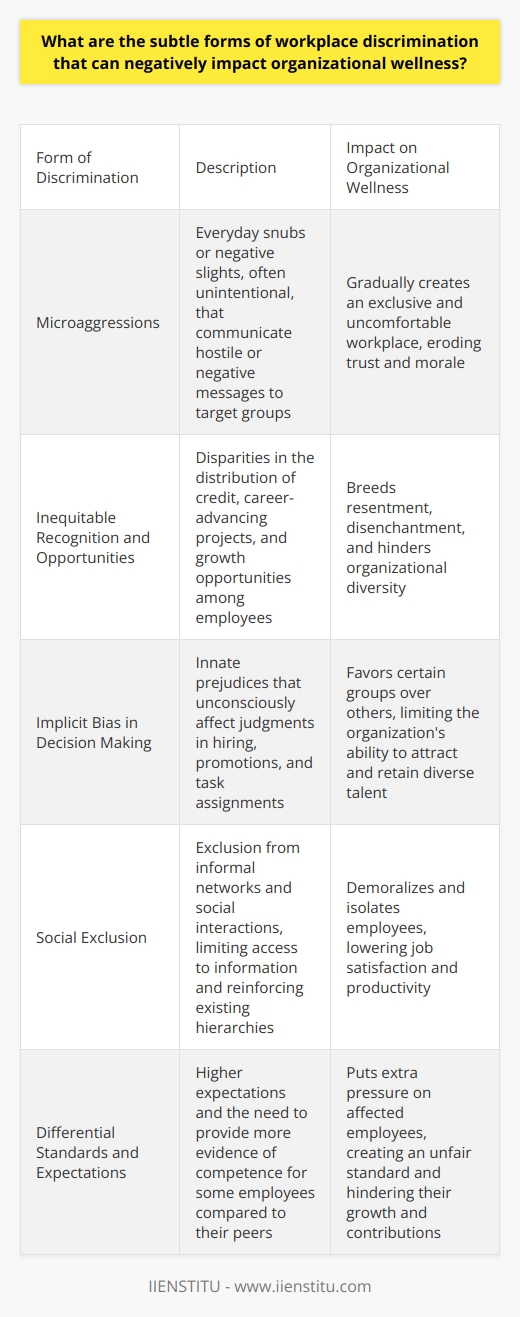
How can workplace discrimination directly affect the overall productivity and morale within an organization?
Understanding Workplace Discrimination
Workplace discrimination occurs when employers treat certain employees unfairly. This unfair treatment is often based on race, gender, age, religion, or disability. Discrimination can manifest in hiring, firing, promotions, or daily job tasks.
Effects on Productivity
Bias hinders performance. Employees who face discrimination often experience stress. This stress affects their focus and efficiency. Anxious workers cannot concentrate as well. Their productivity suffers as a result.
Morale declines. Discrimination can create a hostile work environment. When morale drops, so does the willingness to contribute. Employees may no longer feel motivated to excel.
- Collaboration worsens.
- Teamwork deteriorates.
- Innovation stalls.
Impact on Employee Retention
Discrimination fuels turnover. Workers facing discrimination may leave. Finding and training new staff costs time and money. The company loses valuable knowledge with each departure.
Talent pool shrinks. When discrimination becomes known, potential hires may stay away. Companies struggle to attract skilled candidates. The quality of work declines.
Legal and Financial Repercussions
Legal risks increase. Discrimination can lead to lawsuits. Legal battles drain resources. They pull focus from core business activities.
Reputation suffers. Public discrimination cases damage a company's image. Customers and clients may choose to look elsewhere. Sales and profits can falter.
Strategies to Combat Discrimination
Promote diversity. Organizations must value diverse backgrounds. They must foster inclusive cultures. Fair policies must guide all work interactions.
Provide training. Regular anti-discrimination training is essential. Employees and managers must understand what constitutes discrimination. They must know how to prevent it.
Establish reporting systems. Workers must have safe ways to report discrimination. Clear procedures help address issues quickly. This deters potential discriminatory behavior.
Monitor and evaluate. Companies must regularly assess their workplace climate. Surveys and feedback can reveal discrimination. Swift action to correct issues is necessary.
In conclusion, workplace discrimination can have a profound impact on productivity and morale. It creates stress and hostility, which hinders collaboration and innovation. Furthermore, it leads to high turnover rates and deters potential hires. This not only affects the day-to-day operations but also the legal and financial standing of an organization. Combating discrimination with effective strategies is essential to maintain a productive, motivated, and inclusive workforce.
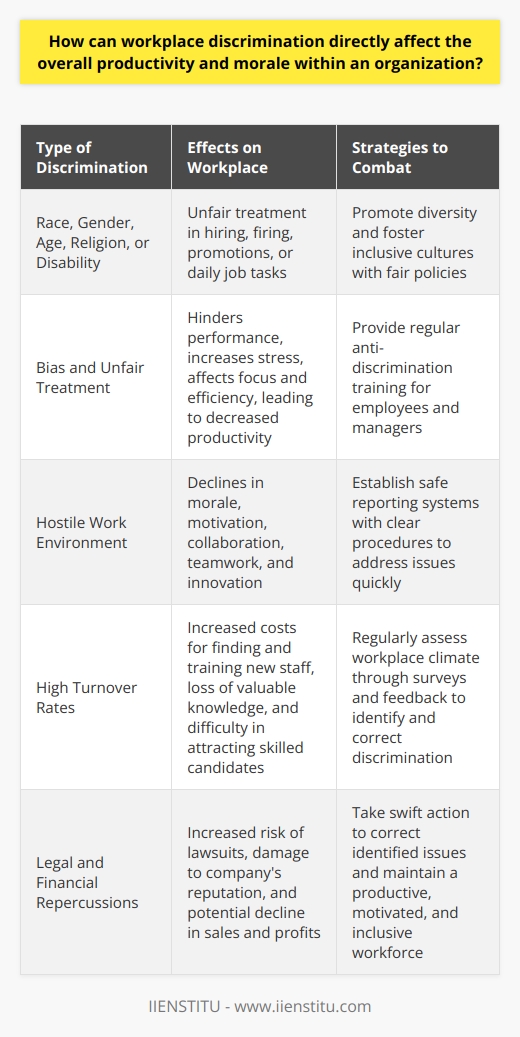
How does an organization's handling of workplace discrimination issues influence their reputation in the industry?
Workplace Discrimination and Organizational Reputation
The Ripple Effect of Discrimination Handling
Organizations face scrutiny over how they handle discrimination. These actions reflect their values. They also signal their commitment to fairness. Effective handling can bolster reputations. Neglect can lead to reputational harm. Industry peers often measure a firm's ethical standing by its discriminative issue management.
Public Perception and Client Trust
The public image of an organization hinges on its integrity. Fair discrimination handling builds public trust. It showcases the leadership's commitment to justice. It signals a safe environment for employees. Customers favor companies with strong ethical principles. They trust firms known for fair treatment. A sound approach can attract talented employees.
The Legal and Ethical Imperative
Laws mandate discrimination-free workplaces. Ethical standards do too. An organization must comply with both. A failure invites legal consequences. It tarnishes the ethical image. Compliance fosters a culture of respect. It exemplifies lawful and moral conduct. Stakeholders value a clear ethical stance. It promotes long-term success.
Talent Retention and Industry Standing
Top talent seeks inclusive workplaces. How a firm manages discrimination impacts this. A positive approach attracts skilled workers. It retains them. It advances the firm's standing in the industry. Peers take note of these practices. They benchmark against them. An organization's handling of discrimination becomes a mark of excellence.
The Impact on Partner and Investor Relations
Partners scrutinize reputation too. They assess risk in associations. Strong discrimination policies reduce partnership risks. They attract investors as well. A well-regarded reputation invites more investment. Investors seek stable, ethical organizations. They shun firms with reputational risks.
Social Responsibility and Community Impact
Organizations function within communities. Their actions have community impacts. Responsibly addressing discrimination fulfills a social role. It can inspire others to act alike. Communities support firms that uphold social justice. They boycott those that don't. Thus, discrimination handling has a broader social influence.
Media Influence and Coverage
The media play a role. They spotlight discrimination issues. They shape public opinion. An organization's response might garner positive coverage. Or, it could lead to negative reports. The media coverage can influence industry views. It amplifies the reach of a company's actions.
Conclusion
In conclusion, workplace discrimination management matters. It shapes a firm's industry reputation. It influences public trust and employee satisfaction. It affects legal compliance and ethical standing. It impacts partnerships, investments, and social relations. In essence, it is a cornerstone for reputational integrity.
